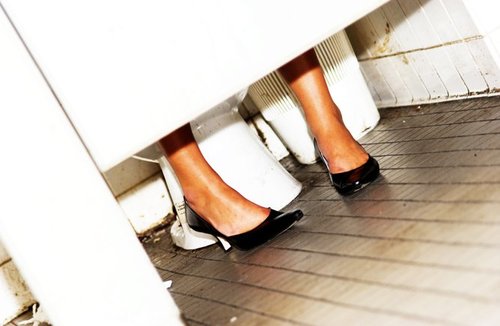
Toilet gymnastics: The ‘Power Pee & Hover’ Approach
Oh, yeah, you know you’ve done it before ladies…walked into the bathroom, questioned the sanitation of the toilet seat, and hovered 6 inches to a foot above the commode praying for good aim (a.k.a.: “popping a squat”)! But, you may have noticed difficulty starting the flow of urine or didn’t feel like you completely ‘got it all out’ at the end so you pushed to finish. When we want to rush away from the germ station as fast as humanly possible, the ‘power pee & hover’ approach is a common form of toilet gymnastics, but if done too often, may lead to pelvic floor dysfunction.
HOVERING
Urination requires a complex neural interplay between the bladder, spinal cord and pelvic floor muscles. When we urinate, our bladder (or detrusor muscle) contracts and the pelvic floor muscles lengthen. This is an innate reflex called the ‘micturition reflex’ that is beautifully orchestrated through a series of neural communication called ‘Bradley’s Loops.’ In Bradley’s loop #3, a neural interplay occurring at the sacral level of the spinal cord, tells the bladder to contract and the pelvic floor to lengthen in order to urinate…
But, you’re HOVERING! This means your pelvic floor muscles (which are postural muscles needed to hold you up) are contracting during your squat! But, aren’t they supposed to lengthen to pee?! Yes, this is where you are asking the pelvic floor muscles to perform two opposing functions at the same time! This lady on the right is squatting for exercise targeting her core; if she wanted to pee she would be better of quieting and lengthening her pelvic floor by coming into a full squat (hips below knees). You may be able to get by doing this display of bathroom gymnastics occasionally (like on the 3rd day of visiting the porta potty at your favorite music festival), but doing it too frequently can lead to neural confusion and in-coordination of the pelvic floor muscles with other activities as well.
So, if you have the ‘fear of public restroom syndrome’ and won’t even sit on the toilet at work, take comfort in knowing that your gym equipment has 400 times the amount of bacteria as a toilet and your cell phone 10x…so, like my grandmother always taught me, if it’s not too nasty, build your nest of toilet paper and sit!
POWER PEEING!
You’re hovering; desperately trying to hold on to something nearby or brace yourself between the stall walls for a little bit of support. And goodness gracious does this get harder balancing in heels!
You know why you are trying to get external support? So your core muscles (i.e. your pelvic floor) can relax and lengthen to let the urine out. But, you remain in a squat, so the tone of the pelvic floor will remain elevated shutting the doors to the urethra.
Tactic #2: You can’t get enough external support to quiet the pelvic floor in a hover so you go internal and put some ‘umph’ behind the bladder by bearing down. Essentially you are increasing your intra-abdominal pressure by FORCING the urine out. But, that’s the BLADDER’S job!
Bladder contraction to push the urine out is dictated neurally by Bradley’s Loop #2. I know you are trying to help the pee situation by pushing, but the bladder is designed to do this on its own! It’s like being in the car with a perfectly capable driver who knows the route, but you keep telling her where to turn…she’s GOT this! Just let her do her job already! But, you wouldn’t make navigating the roads more difficult by blindfolding the driver, so set your bladder up for success; make your little toilet nest and sit down! If you keep power peeing to generate extra bladder ‘umph,’ eventually the bladder might not function as well as it is designed to and you could experience stop and start urination and/or an increase in post-void residual and inability to completely ‘get it all out.’
I’ve heard patient’s report that they bear down quickly to get out the last little bit of urine, but this also will confuse the reflex loop. When the pelvic floor senses a quick increase in intra-abdominal pressure, it should reflexively contract against it (this reflex is incredibly important for maintaining continence with coughing, sneezing and laughing). This ‘cough reflex’ is one demonstration of a coordinated pelvic floor; if you are training your pelvic floor muscles to lengthen as you bear down quickly to get the rest of your urine out, you may be causing in-coordination of the pelvic floor muscles which can translate to altered pelvic floor function with other important activities.
So take heart in knowing that most toilets are cleaner than you may think; make yourself a little nest, sit down and go with the flow…your bladder knows what to do!
If you enjoyed this blog and would like to learn more about healthy bladder habits you may be interested in my blog from last week: The Pee Symphony: Why No Kegels on the Toilet.
If you are a physical therapist or medical practitioner who provides education pertaining to bladder health for your clients, you may like to check out ‘The Bladder Book,’ which is a collection of patient handouts for the medical practitioner…designed to improve efficiency and communication in your practice.
